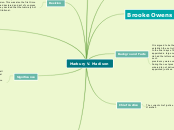American Legal System (Chapter one)
Sources of Judicial Power
Opinions
Dissenting
when a judge or justice write a statement of disagreement with the results of the ruling.
Concurring
when a judge agrees with a ruling but not with the reasoning behind the ruling.
Precedent
courts are expected to follow decisions of similar cases
Vertical Power
Court of last resort (Supreme Court)
Binding on all lower courts
They review the intermediate courts decision to see is laws were correctly applied.
intermediate appellant court
Can appeal to higher court
Binding on courts of it's jurisdiction
They can reverse the trial courts decision if error is found/
Make sure the trial court did not have error and to develop laws,
trial court (district courts)
can appeal to next highest court
Fact finding process occurs
Once facts are found they are the same when going to higher courts unless found that they are biased when they were found.
Horizontal Power
two types of horizontal power
Limited power
The power is limited based on the legislative decision.
Supreme power
the power that the supreme courts act as the ultimate interpreter of the constitution.
Federalism
Federal Government indirectly helps education through grants
Government of US composed of a union of states under a central federal government.
Sources of Law
Case law
Judges interpretations of statutes, regulations, and constitutional provisions.
Regulatory law
The statutory law is very general and because of this they give power to agencies of the executive branch to specify and add regulations to the laws.
The agencies within the department of the law that is in question investigates the situations.
The agencies create regulations that are additions to the law
Statutory law
Process
The law is created by either the house of representatives or senate. The bill is then given to the appropriate committee of the given house. That house then gives it to a subcommittee and then it is reported by a full committee. The bill is then given to the house of senate to debate on and vote on the bill. The bill then passes or dies. If it passes it goes to the other house(house of representatives or senate) and is given to a committee, subcommittee, and then full committee and debated on and voted by the house. If passed by both houses it is given to the conference committee to develop compromise bill. If this is voted to pass then it is given to the president to pass or veto the bill. If the bill passes it becomes a law, if it is vetoed it can pass by a 2/3 vote of congress.
Law that is passed or enacted by congress and state legislatures make statues
Constitutional law
There are state constitutions and federal constitution
All states have educational mandates in their constitutions.
The state constitution can provide more rights beyond the federal constitution but cannot deny rights from the federal one.
Based on the constitution









